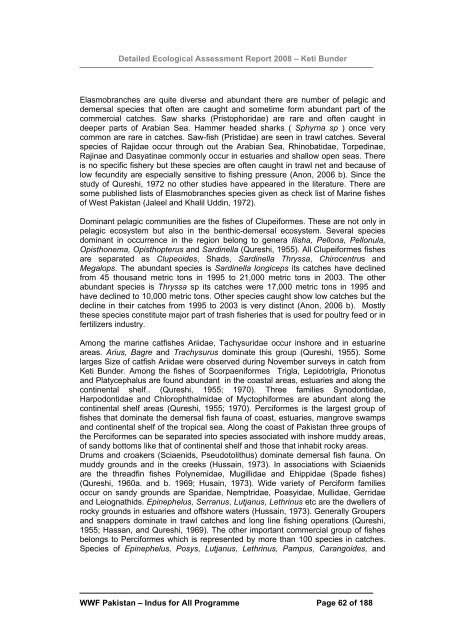Disclaimer note - WWF - Pakistan
Disclaimer note - WWF - Pakistan
Disclaimer note - WWF - Pakistan
You also want an ePaper? Increase the reach of your titles
YUMPU automatically turns print PDFs into web optimized ePapers that Google loves.
Detailed Ecological Assessment Report 2008 – Keti Bunder<br />
Elasmobranches are quite diverse and abundant there are number of pelagic and<br />
demersal species that often are caught and sometime form abundant part of the<br />
commercial catches. Saw sharks (Pristophoridae) are rare and often caught in<br />
deeper parts of Arabian Sea. Hammer headed sharks ( Sphyrna sp ) once very<br />
common are rare in catches. Saw-fish (Pristidae) are seen in trawl catches. Several<br />
species of Rajidae occur through out the Arabian Sea, Rhinobatidae, Torpedinae,<br />
Rajinae and Dasyatinae commonly occur in estuaries and shallow open seas. There<br />
is no specific fishery but these species are often caught in trawl net and because of<br />
low fecundity are especially sensitive to fishing pressure (Anon, 2006 b). Since the<br />
study of Qureshi, 1972 no other studies have appeared in the literature. There are<br />
some published lists of Elasmobranches species given as check list of Marine fishes<br />
of West <strong>Pakistan</strong> (Jaleel and Khalil Uddin, 1972).<br />
Dominant pelagic communities are the fishes of Clupeiformes. These are not only in<br />
pelagic ecosystem but also in the benthic-demersal ecosystem. Several species<br />
dominant in occurrence in the region belong to genera Ilisha, Pellona, Pellonula,<br />
Opisthonema, Opisthopterus and Sardinella (Qureshi, 1955). All Clupeiformes fishes<br />
are separated as Clupeoides, Shads, Sardinella Thryssa, Chirocentrus and<br />
Megalops. The abundant species is Sardinella longiceps its catches have declined<br />
from 45 thousand metric tons in 1995 to 21,000 metric tons in 2003. The other<br />
abundant species is Thryssa sp its catches were 17,000 metric tons in 1995 and<br />
have declined to 10,000 metric tons. Other species caught show low catches but the<br />
decline in their catches from 1995 to 2003 is very distinct (Anon, 2006 b). Mostly<br />
these species constitute major part of trash fisheries that is used for poultry feed or in<br />
fertilizers industry.<br />
Among the marine catfishes Ariidae, Tachysuridae occur inshore and in estuarine<br />
areas. Arius, Bagre and Trachysurus dominate this group (Qureshi, 1955). Some<br />
larges Size of catfish Ariidae were observed during November surveys in catch from<br />
Keti Bunder. Among the fishes of Scorpaeniformes Trigla, Lepidotrigla, Prionotus<br />
and Platycephalus are found abundant in the coastal areas, estuaries and along the<br />
continental shelf.. (Qureshi, 1955; 1970). Three families Synodontidae,<br />
Harpodontidae and Chlorophthalmidae of Myctophiformes are abundant along the<br />
continental shelf areas (Qureshi, 1955; 1970). Perciformes is the largest group of<br />
fishes that dominate the demersal fish fauna of coast, estuaries, mangrove swamps<br />
and continental shelf of the tropical sea. Along the coast of <strong>Pakistan</strong> three groups of<br />
the Perciformes can be separated into species associated with inshore muddy areas,<br />
of sandy bottoms like that of continental shelf and those that inhabit rocky areas.<br />
Drums and croakers (Sciaenids, Pseudotolithus) dominate demersal fish fauna. On<br />
muddy grounds and in the creeks (Hussain, 1973). In associations with Sciaenids<br />
are the threadfin fishes Polynemidae, Mugillidae and Ehippidae (Spade fishes)<br />
(Qureshi, 1960a. and b. 1969; Husain, 1973). Wide variety of Perciform families<br />
occur on sandy grounds are Sparidae, Nemptridae, Poasyidae, Mullidae, Gerridae<br />
and Leiognathids. Epinephelus, Serranus, Lutjanus, Lethrinus etc are the dwellers of<br />
rocky grounds in estuaries and offshore waters (Hussain, 1973). Generally Groupers<br />
and snappers dominate in trawl catches and long line fishing operations (Qureshi,<br />
1955; Hassan, and Qureshi, 1969). The other important commercial group of fishes<br />
belongs to Perciformes which is represented by more than 100 species in catches.<br />
Species of Epinephelus, Posys, Lutjanus, Lethrinus, Pampus, Carangoides, and<br />
<strong>WWF</strong> <strong>Pakistan</strong> – Indus for All Programme Page 62 of 188

















